Cookbook #227: Mastering the Art of French Cooking, Julia Child, Louisette Bertholle, Simone Beck, Borzoi Books, Alfred A. Knopf, NY, 1961. Thirtieth Printing, June, 1978.
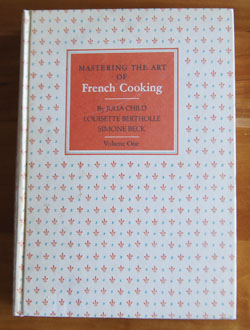
“Julie & Julia”, the 2009 film starring Meryl Streep and Amy Adams, portrays the true story of Julie Powell, a young New Yorker who took on the challenge of cooking all 524 recipes in Mastering the Art of French Cooking. She covered her experiences in a blog, and eventually a book: Julie and Julia: 365 Days, 524 Recipes, 1 Tiny Apartment Kitchen. When the movie came out, I ran upstairs to see if I had a copy of Mastering the Art of French Cooking. And yes, it was on my bookshelf!
Mastering the Art of French Cooking always intimidated me. My copy is barely wrinkled, no food stains mar the pages. In the past, no more did I want to read it that I would want to read a book on advanced physical chemistry.
I’ve grown up a bit though, and taken a class on classic French sauces. I’ve also learned how to make my own great stocks. I’ll say “I am wiser”, and am feeling this especially this week because I just turned a year older. Now as I turn the pages of Mastering the Art of French Cooking, I can understand the language and appreciate the wisdom, and I smile warmly at Julia Child’s complete love of cooking.
On my birthday this week, I got up late and decided to make an omelet. And I don’t just mean “make an omelet”, I wanted to make an omelet according to Julia’s directions. I wanted nothing else for breakfast! Just an experiment. It was, afterall, my birthday.
I open Mastering the Art of French Cooking to page 127. Julia Child says it will only take 30 seconds to make the omelette. And, “An omelette cannot be made in a sticky pan. The eggs must be able to slide around freely. This is why it is a good idea to have one pan that is reserved for omelettes only.” And the type of pan Julia Child likes the best? The French type of plain iron pan with sloping sides. Aha, I own just such a pan! I got it about a year ago. But I banished it to the basement because it is so heavy and hard to clean.
Today I jog down to the basement and retrieve the pan. I scrub it with steel wool and soap, dry it carefully, and heat it to get all the water off. Then I rub it with oil and wipe all that off. I set it on the stove.
“The individual 2- to 3-egg omelette is usually the tenderest, and by far the best size to practice making.” Perfect. “Just before heating the butter in the pan, break the eggs into a mixiing bowl and add salt and pepper. With a large table fork, beat the eggs only enough to blend the whites and yolks thoroughly. From 30 to 40 vigorous strokes should be sufficient.”
My 3 eggs mixed with 30 vigorous strokes, it’s time to heat my pan. “Place the butter [1 tablespoon] in the pan and set over very high heat . . . as the butter melts, tilt the pan in all directions to film the sides. When you see that the foam has almost subsided in the pan and the butter is on the point of coloring, it is an indication that it is hot enough to pour in the eggs.”
Next comes the short but busy omelette-cooking step. I am to hold the (heavy) pan in my left hand, pour in the eggs, and immediately start sliding the pan back and forth rapidly over the heat. And at the same time, I am supposed to stir the eggs with the bottom flat side of a fork to spread them all over the bottom of the pan. In only 3 or 4 seconds, the eggs will become a light custard, and it will be time to tilt the pan at a 45 degree angle and gather the eggs at the far lip of the pan. And give “4 or 5 sharp blows on the handle of the pan with your right fist to loosen the omelette and make the far edge curl over onto itself.”
This all happened very fast. But somehow, I poured a creamy, soft roll of eggs onto a plate. No toast, no coffee cake, no sausage, just eggs. I immediately take the hot omelette and two forks and sit down next to my husband. He gives me this look, as if, he is supposed to share this with me? “It’s my birthday, I can do what I want!”
I took the first bite and . . . heavenly tastes and textures burst in my mouth. Dang that was a great omelette. Thank you Julia Child!
I spend several days paging through Mastering the Art of French Cooking. I took lots of notes! I really do like this classic cookbook. I suggest every serious cook buy or borrow a copy at some point in their life.
The only drawback to Julia Child’s recipes is the heavy use of butter, cream, and egg yolks. Yes, I have read The Big Fat Surprise, a book that disputes the generally accepted idea that the fats in these foods are bad for you, and instead encourages us to include them in our diet. But still, calories are calories, and stick on my body as weight when I eat too many. Just saying.
But this week, I will indulge in a Julia Child recipe: Filets de Poisson Gratinés, à la Parisienne, or “Fish Filets Poached in White Wine; Cream and Egg Yolk Sauce.” This recipe is a great example of Julia Child’s presentation style.
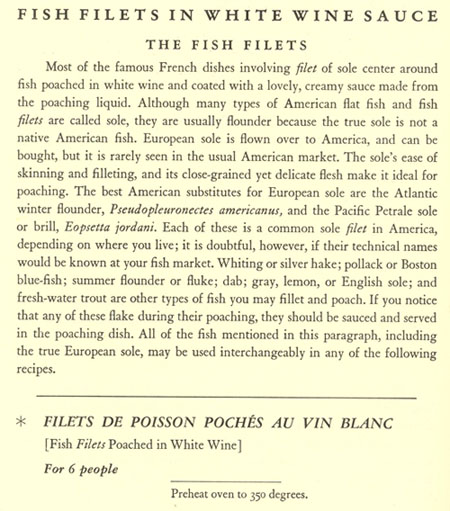
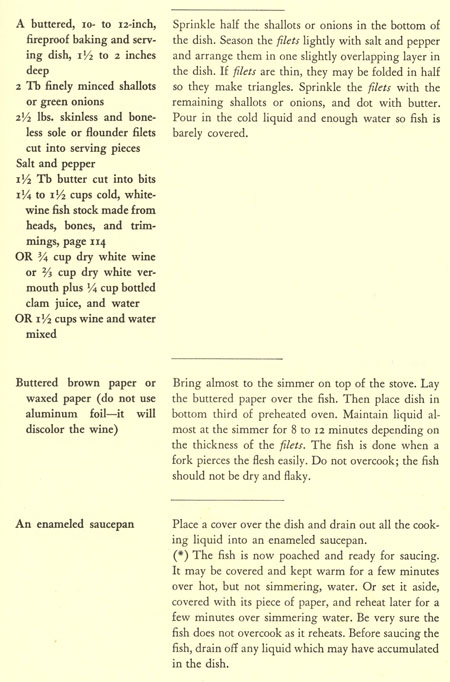

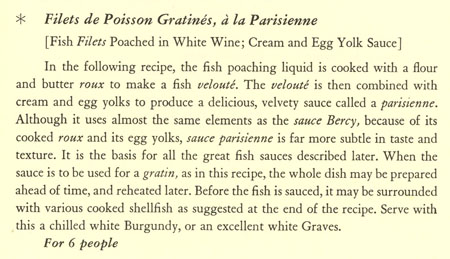
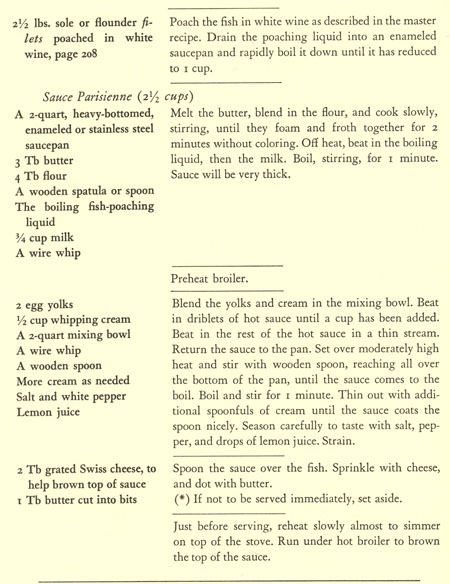
Below is my adaptation of this recipe. Note that you need a baking dish that you can heat on the stove top and also place in the oven. I used a LeCreuset.
Poached Sole in Velouté Sauce
serves 2
Poaching the fish:
- 1 pound sole filets
- 1 tablespoon minced shallots
- butter: you need this throughout; I used unsalted butter, less than a cube in all
- salt and pepper
- 1/2 cup fish stock (or use water)
- 1/2 cup white wine
- a piece of parchment cut to fit the LeCreuset
Turn on the oven to 350˚.
Butter the bottom of a LeCreuset. Sprinkle in half the minced shallots. Season the sole filets with salt and pepper, then place in the prepared LeCreuset, slightly overlapping the filets. Dot with 3/4 tablespoon butter cut into small chunks. Combine the fish stock and the wine and pour over the fish. Add a little more stock if necessary to barely cover the fish. Mine looked like this:

On the stovetop, bring the fish almost to simmering. Butter both sides of the piece of parchment. Place the LeCreuset in the 350˚ oven. Bake for 8 minutes, check for doneness by piercing with a fork (you should find just a slight resistance), and bake a few more minutes only if necessary. During the baking, the cooking liquid should be at a light simmer.
Drain the cooking liquid into a small saucepan, leaving the poached fish in the LeCreuset, covered with the parchment.
Boil the cooking liquid until it is reduced to 1/2 cup. This will be use in the sauce.
Veloute Sauce:
- 1 1/2 tablespoons butter
- 2 tablespoons flour
- 1/2 cup reduced cooking liquid (hot)
- 3/8 cup milk
- 1 egg yolk
- 1/4 cup cream
- “drops” of lemon juice
- 1/2 tablespoon butter
- 1 tablespoon grated Swiss cheese
Melt the 1 1/2 tablespoons butter in a small sauce pan, then add the flour and stir until it is all mixed in. Continue cooking until it thickens but do not cook it until it browns. Off heat, beat in the hot cooking liquid and the milk. A whisk works well for this step. Put the pan back on the stove and bring to a boil, stirring constantly. Boil about a minute – the mixture will be thick.
In a bowl, blend the egg yolk with the cream, using a whisk. Add small amounts of the hot sauce and continue beating until about 1/2 cup of the hot sauce is added, then add the rest of the hot sauce in a thin stream. Put the mixture back in the pan and boil and stir 1 minute. You can thin with a little cream if it is too thick for your tastes. Add a few drops of lemon juice and salt and pepper.
Preheat the broiler.
Spoon the sauce over the poached fish (take the parchment off first), then dot the top with the 1/2 tablespoon butter and the Swiss cheese. On the stove top, over low heat, heat until it is just simmering.
Put the dish under the broiler until the top of the sauce is brown.
What is nice about this dish is that you can assemble it with the poached fish covered with sauce, and then do the stove-top heating and broiling steps just before serving. It’s important to bring this dish to the table hot and bubbly.
Here is the plated dish.
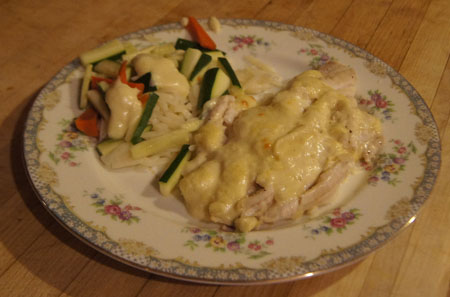 I served with a little orzo and steamed julienned zucchini and carrots on the side. I also served a loaf of my own no-knead bread. And a couple pretty green salads. For dessert? Fresh blackberries over ice cream.
I served with a little orzo and steamed julienned zucchini and carrots on the side. I also served a loaf of my own no-knead bread. And a couple pretty green salads. For dessert? Fresh blackberries over ice cream.
I took my first bite of the fish and then I had to set down my fork so I wouldn’t gobble up the rest too fast. This is absolutely delicious! “One of the best twenty-five meals ever in my life” was my comment.
Thank you Julia Child.

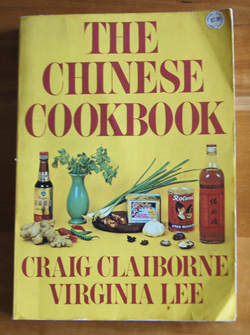 The Chinese Cookbook is one of my favorite cookbooks. I always keep it in my kitchen for ready reference!
The Chinese Cookbook is one of my favorite cookbooks. I always keep it in my kitchen for ready reference!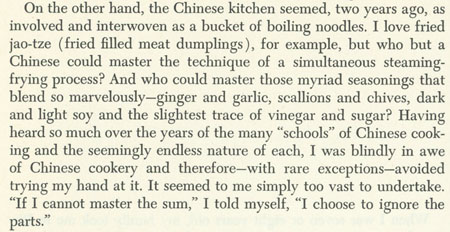 Claiborne goes on to talk about his fourteen year stint as the food news editor and restaurant critic for the New York Times, saying “I was tired. I neeeded rest and a respite from cooking. And then I met Virginia Lee.”
Claiborne goes on to talk about his fourteen year stint as the food news editor and restaurant critic for the New York Times, saying “I was tired. I neeeded rest and a respite from cooking. And then I met Virginia Lee.”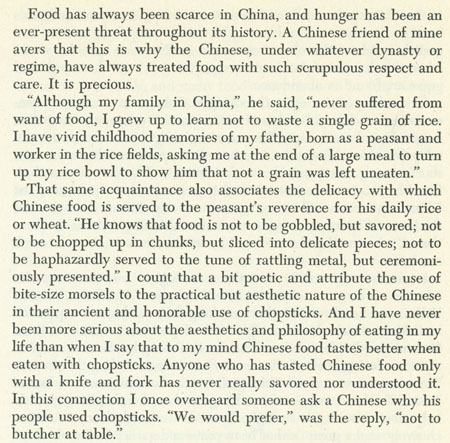 I learned how to make most of my current repertoire of Chinese dishes from The Chinese Cookbook. The recipes are easy to follow, even though the ingredient lists might look daunting with exotic ingredients. For instance, Hot and Sour Soup:
I learned how to make most of my current repertoire of Chinese dishes from The Chinese Cookbook. The recipes are easy to follow, even though the ingredient lists might look daunting with exotic ingredients. For instance, Hot and Sour Soup: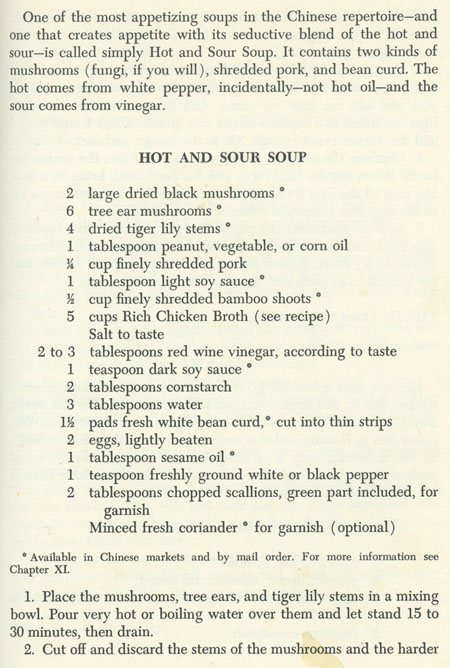
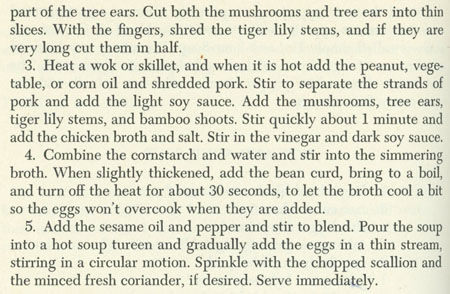 I’ve made this Hot and Sour Soup many times. Dried black mushrooms, tree ear mushrooms, and dried tiger lily stems! Ages ago, I had to go all the way to Denver to a Chinese market to find all of these ingredients. Nowadays I go to the Asian Seafood Market in Boulder. Sometimes I leave out these exotic ingredients, if I have none on hand, or I use fresh shitakes and skip the tree ear and black mushrooms tiger lilies. Not as much fun, but still a good soup.
I’ve made this Hot and Sour Soup many times. Dried black mushrooms, tree ear mushrooms, and dried tiger lily stems! Ages ago, I had to go all the way to Denver to a Chinese market to find all of these ingredients. Nowadays I go to the Asian Seafood Market in Boulder. Sometimes I leave out these exotic ingredients, if I have none on hand, or I use fresh shitakes and skip the tree ear and black mushrooms tiger lilies. Not as much fun, but still a good soup.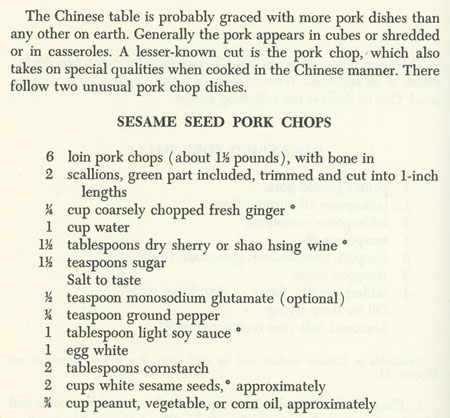
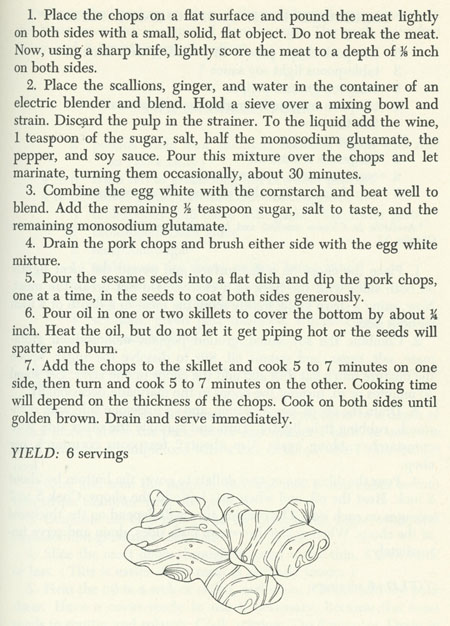 I made these pretty much as per the above recipe, except I left out the monosodium glutamate, and I halved the recipe for two people, but did not halve the amount of egg white/cornstarch mixture. I used bone-in pork sirloin chops, but actually, next time I’d prefer to use boneless pork sirloin.
I made these pretty much as per the above recipe, except I left out the monosodium glutamate, and I halved the recipe for two people, but did not halve the amount of egg white/cornstarch mixture. I used bone-in pork sirloin chops, but actually, next time I’d prefer to use boneless pork sirloin.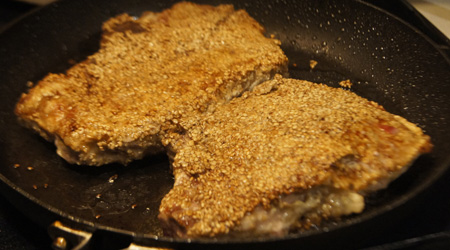 To serve, I sliced the cooked chops into large chunks. It was messy because I had to avoid the bone. But, the pork was very, very juicy and flavorful. I served with fried rice and snow peas and fresh shitakis.
To serve, I sliced the cooked chops into large chunks. It was messy because I had to avoid the bone. But, the pork was very, very juicy and flavorful. I served with fried rice and snow peas and fresh shitakis.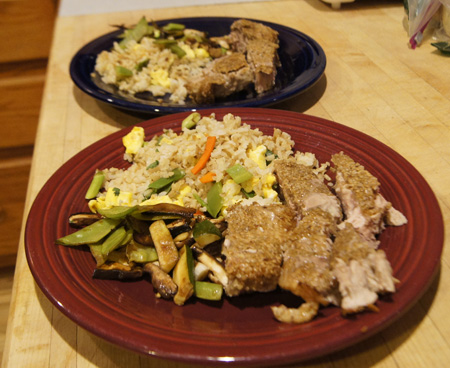
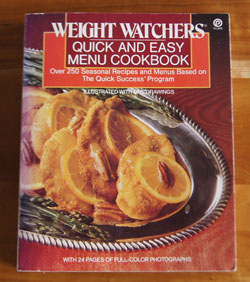 This is the second Weight Watchers book that I have covered in this blog, the other was
This is the second Weight Watchers book that I have covered in this blog, the other was 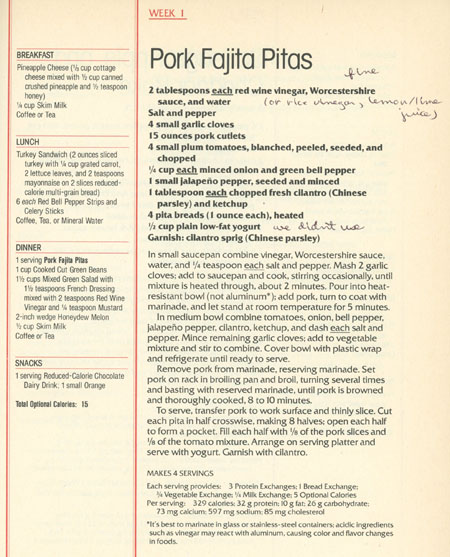
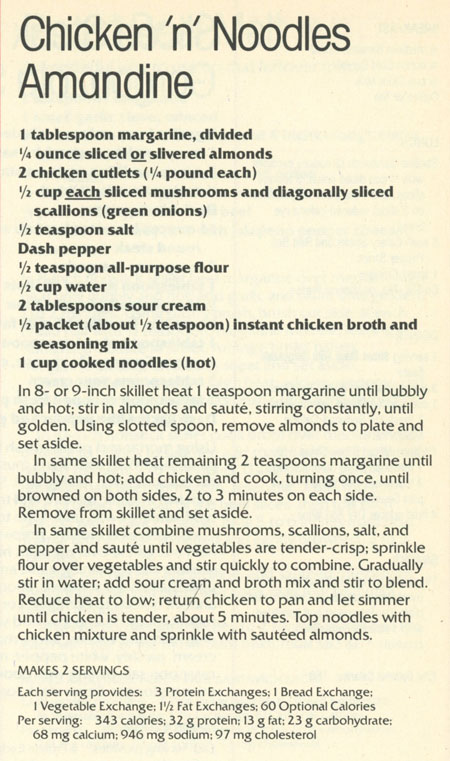
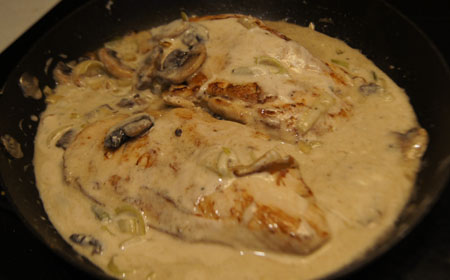 And our plated meal:
And our plated meal: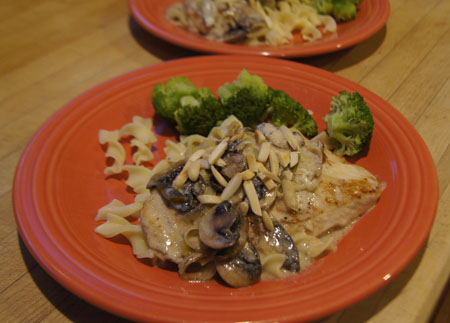
 This is the fifth and last book that I own in the Foods of the World series. Once again, I look forward to discovering another interesting author as I open Cooking of Germany, just as I discovered M. F. K. Fisher in the
This is the fifth and last book that I own in the Foods of the World series. Once again, I look forward to discovering another interesting author as I open Cooking of Germany, just as I discovered M. F. K. Fisher in the 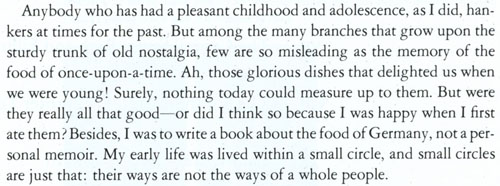

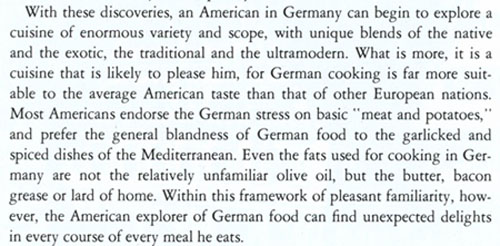 This book has wonderful full-page photographs. The photographer was German-born Ralph Crane, who worked for the NY Times as well as Time-Life books. Here is an example of the full-page photos in this book:
This book has wonderful full-page photographs. The photographer was German-born Ralph Crane, who worked for the NY Times as well as Time-Life books. Here is an example of the full-page photos in this book: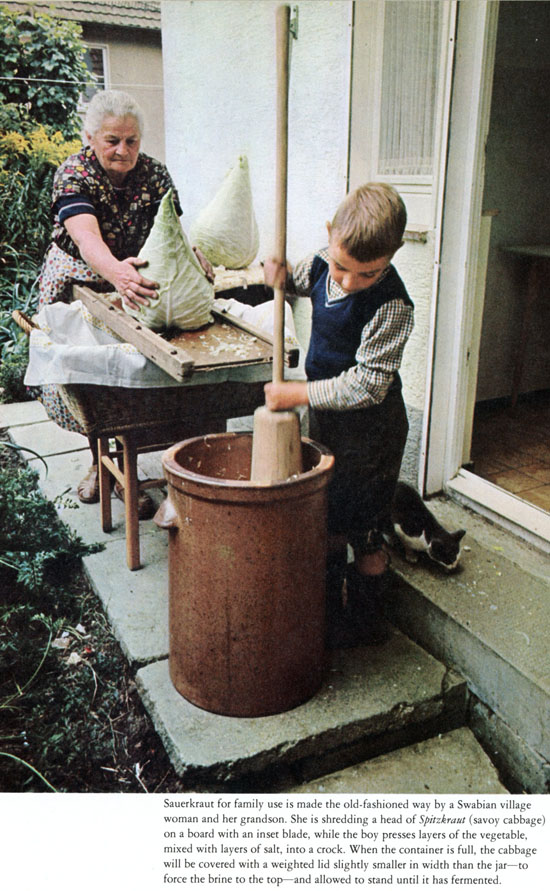
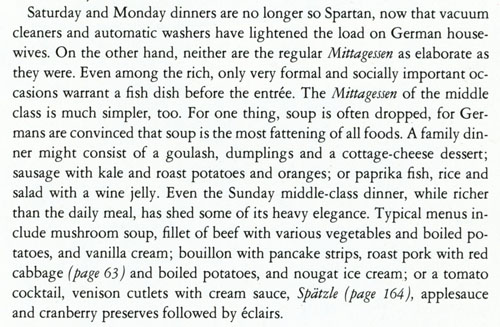
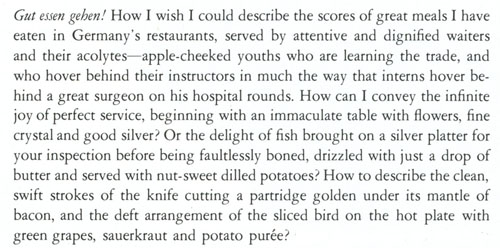
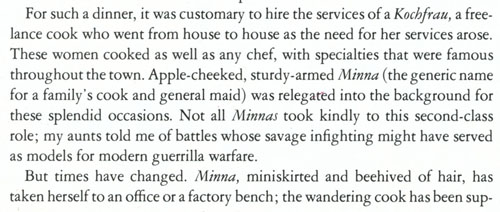

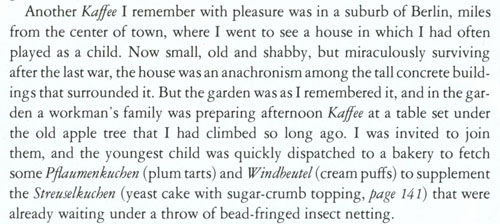 The flavor and of the Cooking of Germany continues to the end of the book. The next chapters are “A Cooking History 2,000 Years Old”, “The Northern Style: Cold-Climate Cuisine”, “The Central Style: Rich and Filling”, “The Southern Style: A lighter Touch”, “Baking Raised to a Fine Art”, and “Festive Revelry and Nostalgic Holidays”. Here are a few thoughts about these chapters.
The flavor and of the Cooking of Germany continues to the end of the book. The next chapters are “A Cooking History 2,000 Years Old”, “The Northern Style: Cold-Climate Cuisine”, “The Central Style: Rich and Filling”, “The Southern Style: A lighter Touch”, “Baking Raised to a Fine Art”, and “Festive Revelry and Nostalgic Holidays”. Here are a few thoughts about these chapters.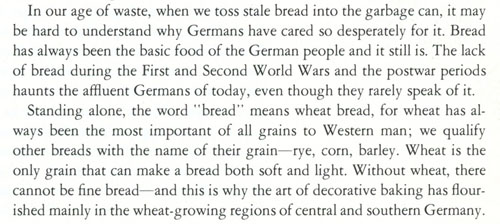
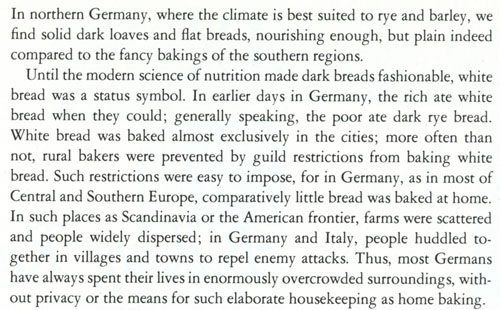

 As suggested in the recipe, I’ll serve it with a little Red Cabbage with Apples.
As suggested in the recipe, I’ll serve it with a little Red Cabbage with Apples.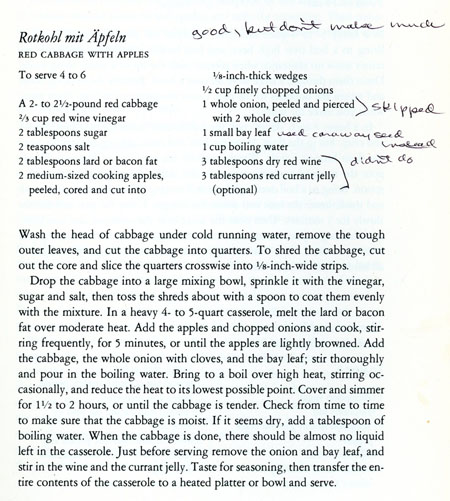

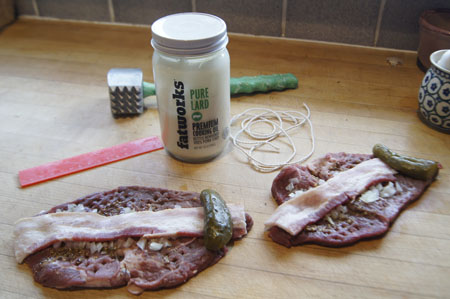
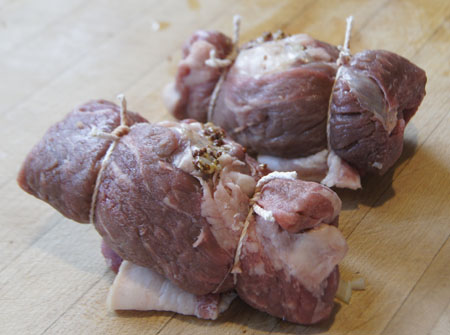 Choose a deep skillet with a heavy lid. I used my old cast-iron stewing pot; a LeCreuset or any heavy cooking pan or pot or skillet would work. Heat the skillet over moderate heat; add the lard (or butter) and heat until it begins to splutter. Add the beef rolls, and brown them on all sides, regulating the heat so they color quickly and evenly without burning. Transfer the rolls to a plate and set aside.
Choose a deep skillet with a heavy lid. I used my old cast-iron stewing pot; a LeCreuset or any heavy cooking pan or pot or skillet would work. Heat the skillet over moderate heat; add the lard (or butter) and heat until it begins to splutter. Add the beef rolls, and brown them on all sides, regulating the heat so they color quickly and evenly without burning. Transfer the rolls to a plate and set aside.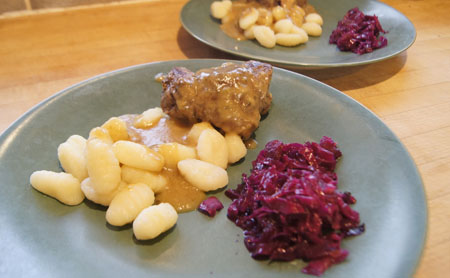 These were delicious! The gravy was amazing, thick and full of flavor. The pickle inside was fun. These remind us of one of our favorite meals, called “little piggies” by my husband’s family. It’s still about his favorite meal – strips of bacon on strips of round steak, rolled and secured with a toothpick, cooked in a skillet and served over mashed potatoes with gravy. I like the rouladen as made above with tender sirloin steak, because there is less fuss in preparation, and the de-fatted gravy isn’t greasy.
These were delicious! The gravy was amazing, thick and full of flavor. The pickle inside was fun. These remind us of one of our favorite meals, called “little piggies” by my husband’s family. It’s still about his favorite meal – strips of bacon on strips of round steak, rolled and secured with a toothpick, cooked in a skillet and served over mashed potatoes with gravy. I like the rouladen as made above with tender sirloin steak, because there is less fuss in preparation, and the de-fatted gravy isn’t greasy.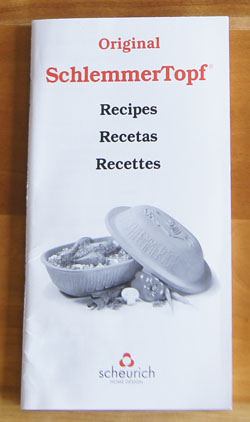 A “Schlemmertopf” is a covered clay baking pot. I wrote a lot of material on clay pots in
A “Schlemmertopf” is a covered clay baking pot. I wrote a lot of material on clay pots in 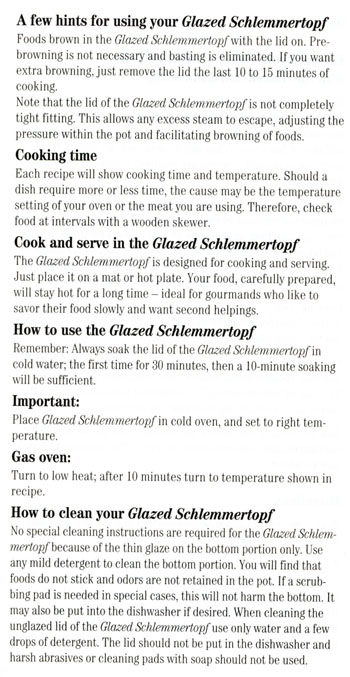 And Six Golden Rules:
And Six Golden Rules: The first 23 pages of this booklet is written in English, then (as far as I can tell) the same instructions and recipes are written in Spanish and then in French. Example recipes are stuffed flank steak, beef stew, meat loaf, beef cabbage rolls, roast beef, chicken shanghai (I made this for
The first 23 pages of this booklet is written in English, then (as far as I can tell) the same instructions and recipes are written in Spanish and then in French. Example recipes are stuffed flank steak, beef stew, meat loaf, beef cabbage rolls, roast beef, chicken shanghai (I made this for 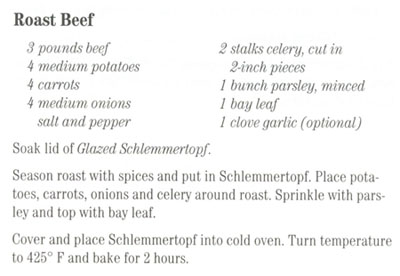 My roast is only about a pound and a half, so I will cut the recipe in half. Note how the recipe (above) does not state what cut of beef to use, nor does it tell me if the potatoes, carrots, and onions are to be peeled or chopped. It does direct the cook to cut the celery in “2-inch pieces”. I decided to peel and cut in half the potatoes, carrrots, and onions.
My roast is only about a pound and a half, so I will cut the recipe in half. Note how the recipe (above) does not state what cut of beef to use, nor does it tell me if the potatoes, carrots, and onions are to be peeled or chopped. It does direct the cook to cut the celery in “2-inch pieces”. I decided to peel and cut in half the potatoes, carrrots, and onions.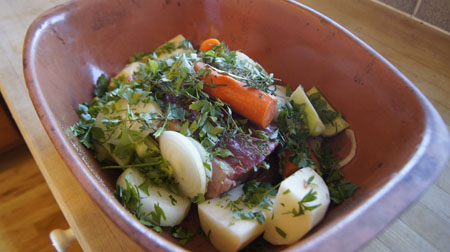
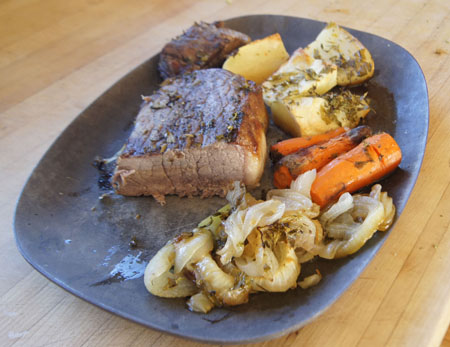 This was good. The potatoes were nicely browned and not mushy inside. I liked the onions too – browned and soft and perfect. I wasn’t able to make a gravy, so I served it with ketchup. (I liked the
This was good. The potatoes were nicely browned and not mushy inside. I liked the onions too – browned and soft and perfect. I wasn’t able to make a gravy, so I served it with ketchup. (I liked the 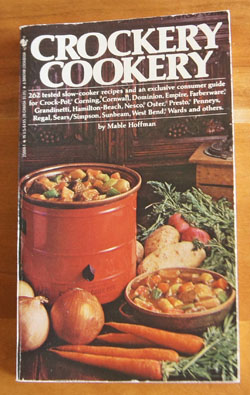 I just now realized: This paperback book has the same title and cover photo and publication date as my hardcover book
I just now realized: This paperback book has the same title and cover photo and publication date as my hardcover book 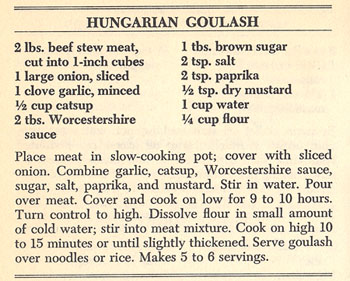 The recipe calls for beef stew meat, but I have a quantity of pork loin in the freezer so I decide to use that instead of beef.
The recipe calls for beef stew meat, but I have a quantity of pork loin in the freezer so I decide to use that instead of beef.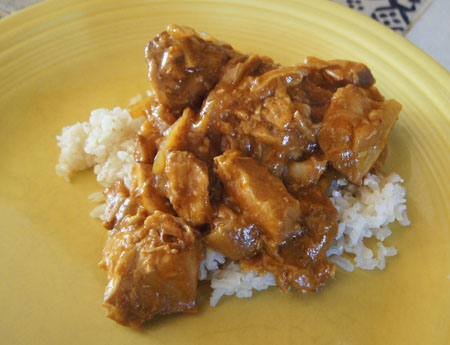 This was very good. I’d make it again!
This was very good. I’d make it again!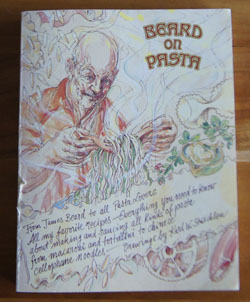
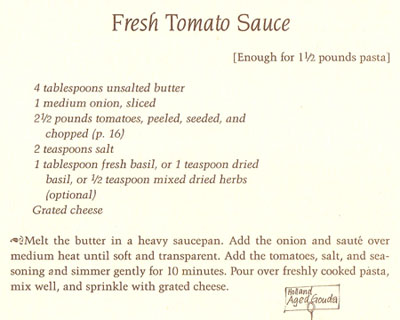 The tomatoes need to be peeled, seeded, and chopped, and Beard has directions for this on page 16. In a class at the
The tomatoes need to be peeled, seeded, and chopped, and Beard has directions for this on page 16. In a class at the 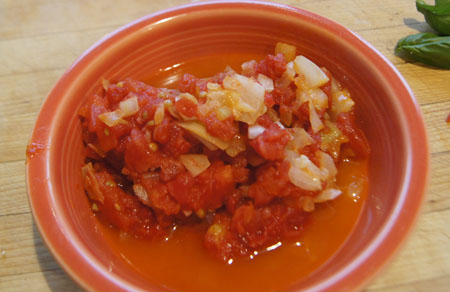 I am inspired by Beard’s “Pasta with Beans” recipe on page 90. The ingredients are: white beans, bacon, onions, carrots, herbs, canned tomatoes, and elbow macaroni. I have some great home-cooked
I am inspired by Beard’s “Pasta with Beans” recipe on page 90. The ingredients are: white beans, bacon, onions, carrots, herbs, canned tomatoes, and elbow macaroni. I have some great home-cooked 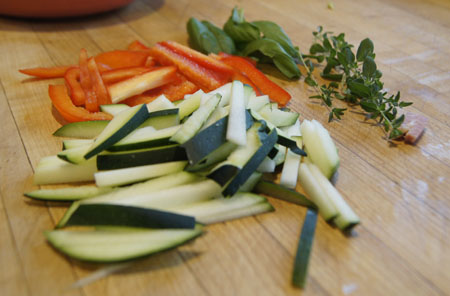
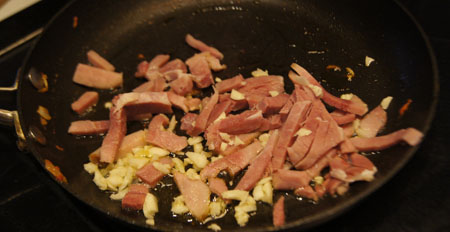 Beard is big on cheese. But, I don’t have a lot of good, chunk Parmesan cheese in my refrigerator – and I’ve decided to make this meal with what I have on hand. I sniff all my cheeses, grate up the last (hard) chunk of Parmesan, add a bit of another sharp white cheese, and use the last of my pre-shredded Parmesan.
Beard is big on cheese. But, I don’t have a lot of good, chunk Parmesan cheese in my refrigerator – and I’ve decided to make this meal with what I have on hand. I sniff all my cheeses, grate up the last (hard) chunk of Parmesan, add a bit of another sharp white cheese, and use the last of my pre-shredded Parmesan. I made a loaf of
I made a loaf of 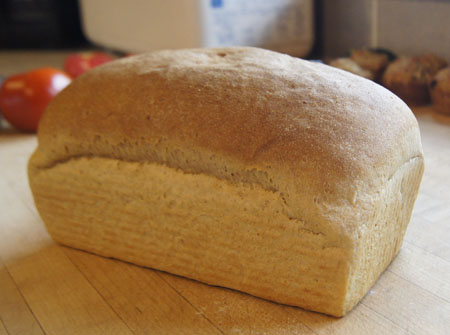
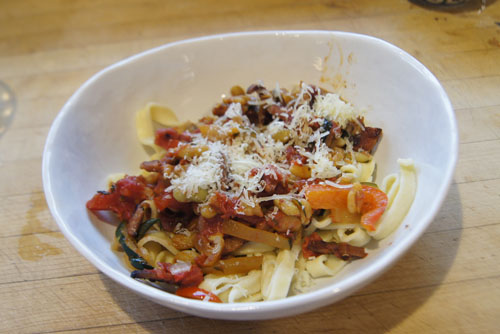
 This booklet of 26 recipes must have come with our Weber gas grill. I have forgotten all about this cookbook, since soon after getting the grill I purchased Weber’s Real Grilling, a large cookbook with tons of recipes.
This booklet of 26 recipes must have come with our Weber gas grill. I have forgotten all about this cookbook, since soon after getting the grill I purchased Weber’s Real Grilling, a large cookbook with tons of recipes.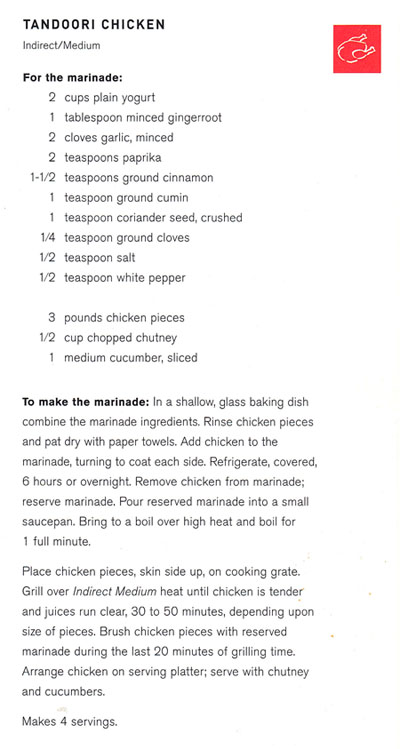
 These tasted great! The yogurt marinade makes them not only well seasoned, it also makes them very tender. (I put the blackened side down for the photo. They would have been so much prettier if I hadn’t tried something experimental!)
These tasted great! The yogurt marinade makes them not only well seasoned, it also makes them very tender. (I put the blackened side down for the photo. They would have been so much prettier if I hadn’t tried something experimental!)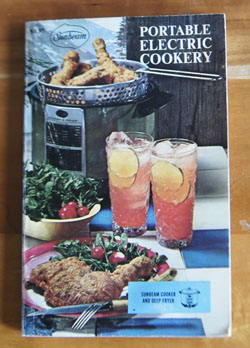 I wrote in my database that Portable Electric Cookery “came with my deep fat fryer”, and it has recipes written for deep fat fryers, electric fry pans, blenders, and electric mixers. I covered the deep fat fryer in
I wrote in my database that Portable Electric Cookery “came with my deep fat fryer”, and it has recipes written for deep fat fryers, electric fry pans, blenders, and electric mixers. I covered the deep fat fryer in 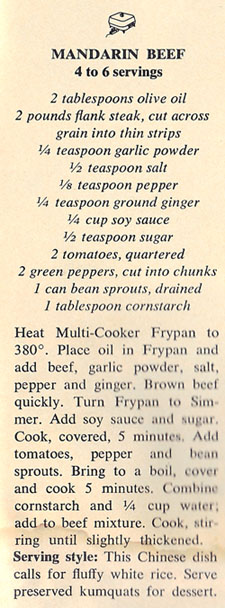 I don’t feel like pulling out my electric fry pan, so I’ll just use one of my stove-top frying pans. For the two of us, I’ll halve the recipe. Instead of the canned bean sprouts, I will substitute with julienned zucchini (I would have used fresh bean sprouts, but forgot to buy them!). I did have mushrooms, so I used them in this dish. And I’ll use fresh ginger and garlic. Tomatoes and fresh ginger and garlic remind me of the base for many dishes my daughter cooked for us in Togo. I think we will like this Mandarin Beef.
I don’t feel like pulling out my electric fry pan, so I’ll just use one of my stove-top frying pans. For the two of us, I’ll halve the recipe. Instead of the canned bean sprouts, I will substitute with julienned zucchini (I would have used fresh bean sprouts, but forgot to buy them!). I did have mushrooms, so I used them in this dish. And I’ll use fresh ginger and garlic. Tomatoes and fresh ginger and garlic remind me of the base for many dishes my daughter cooked for us in Togo. I think we will like this Mandarin Beef.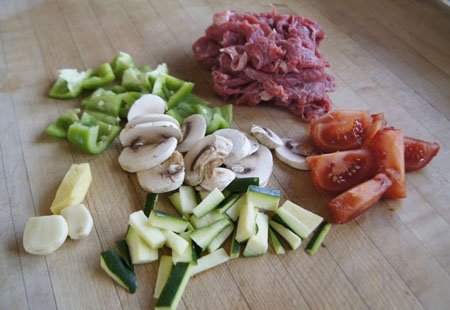
 The title page of this booklet is marked “$1.50” in very neat handwriting. My guess is that I bought it in a Boulder bookstore, way back when. Today I could buy it for $3.95 on Amazon.
The title page of this booklet is marked “$1.50” in very neat handwriting. My guess is that I bought it in a Boulder bookstore, way back when. Today I could buy it for $3.95 on Amazon. The trend for whole grains continues today (2017). I like them because they have much more flavor than plain white bread, or white rice. Whole grains have a low glycemic index, touted in
The trend for whole grains continues today (2017). I like them because they have much more flavor than plain white bread, or white rice. Whole grains have a low glycemic index, touted in 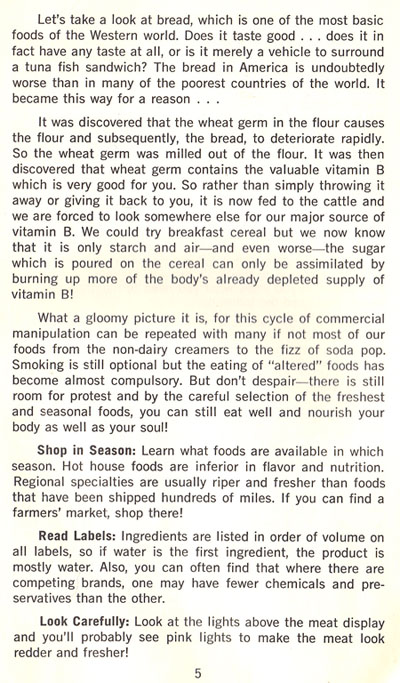
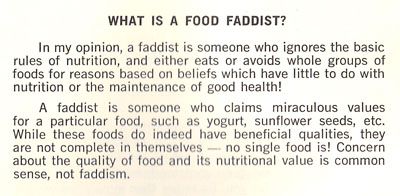
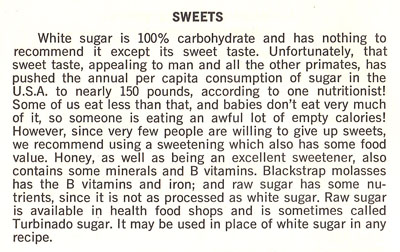
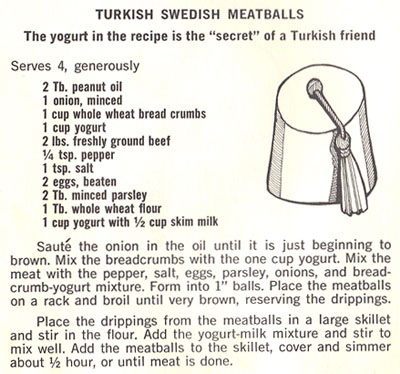 I cut the recipe in half for the two of us. I found the meatballs too sloppy as I formed them, so I added more breadcrumbs. I found it very hard to stir the whole wheat flour into the drippings, so next time I’d use white (AP) flour. (Not worth the trouble using whole grains for this small amount of flour, if it doesn’t work.) Below is my version of this recipe.
I cut the recipe in half for the two of us. I found the meatballs too sloppy as I formed them, so I added more breadcrumbs. I found it very hard to stir the whole wheat flour into the drippings, so next time I’d use white (AP) flour. (Not worth the trouble using whole grains for this small amount of flour, if it doesn’t work.) Below is my version of this recipe.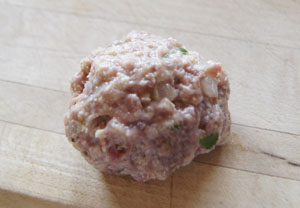 Set the meatballs to rest on a plate or breadboard. Heat your oven to broil. Find a clean broiler pan, or use a rack set over a pan to catch the drippings. Lightly oil the broiler pan or the rack, then place the meatballs on it. Broil the meatballs until they are very brown. This took me 5-10 minutes; I rotated the pan often and turned the oven to low-broil about halfway through.
Set the meatballs to rest on a plate or breadboard. Heat your oven to broil. Find a clean broiler pan, or use a rack set over a pan to catch the drippings. Lightly oil the broiler pan or the rack, then place the meatballs on it. Broil the meatballs until they are very brown. This took me 5-10 minutes; I rotated the pan often and turned the oven to low-broil about halfway through.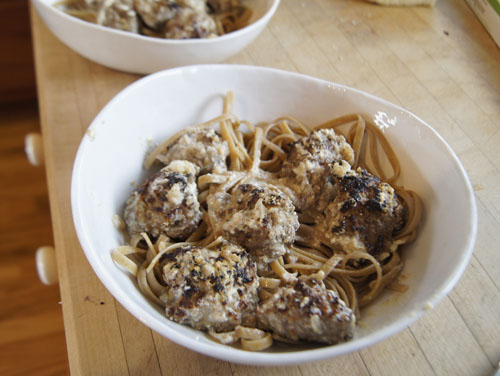 I was surprised at how well these went over! The first comment from my dining-partner was “ummmm, these are good!” I too liked them. Full of flavor and nice and moist.
I was surprised at how well these went over! The first comment from my dining-partner was “ummmm, these are good!” I too liked them. Full of flavor and nice and moist.